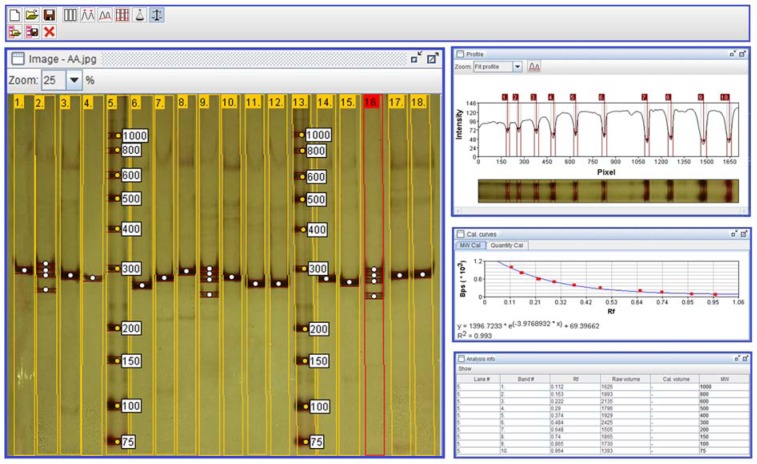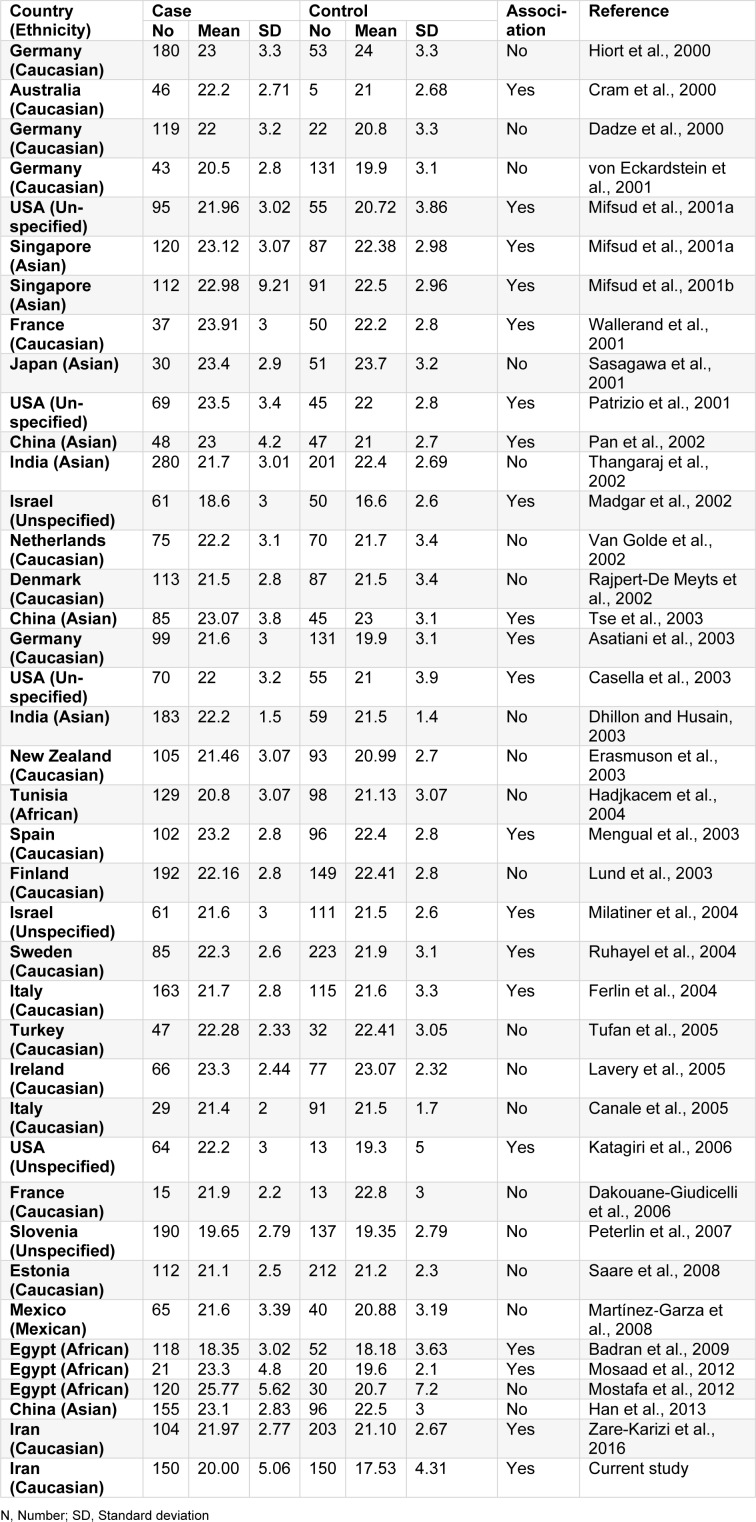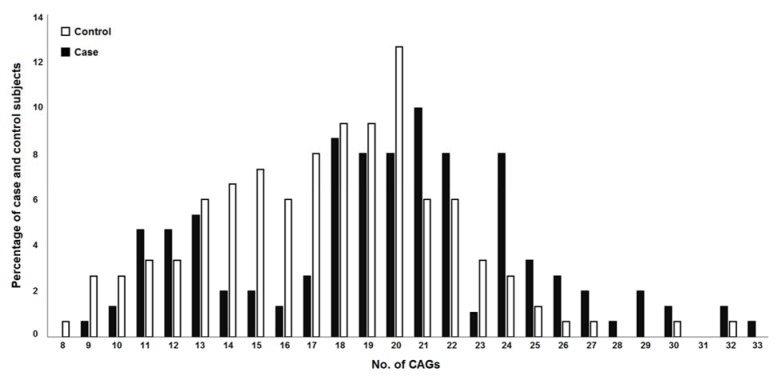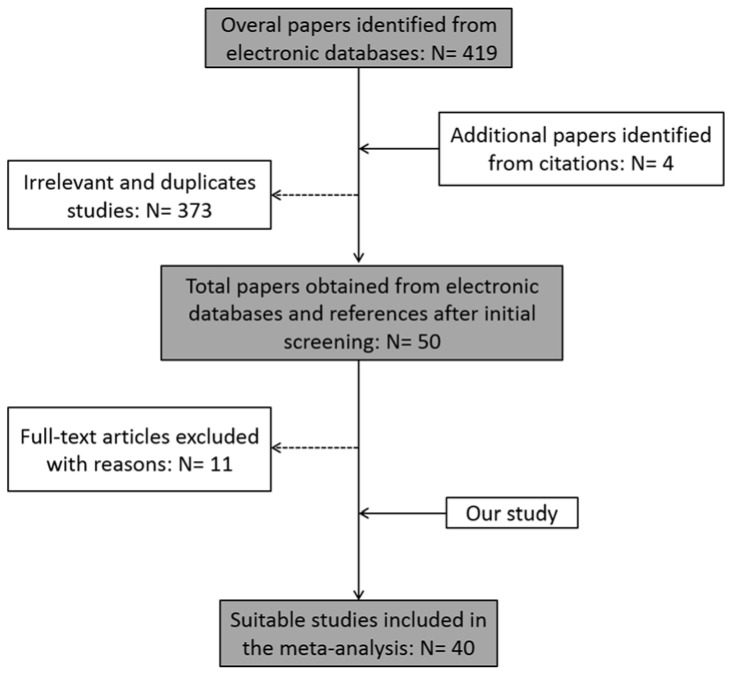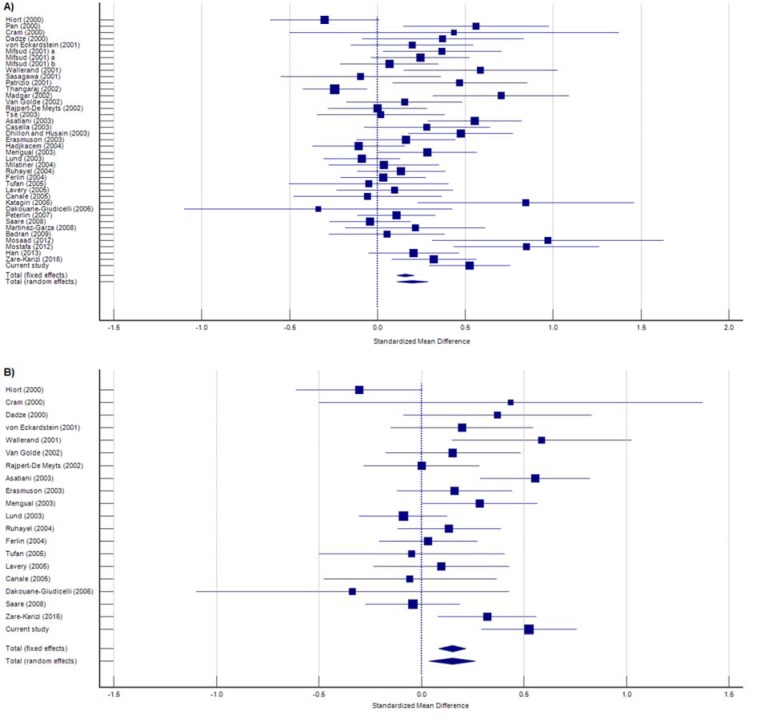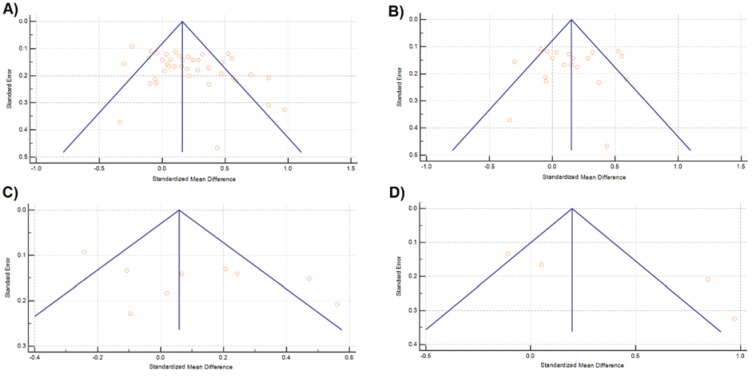Abstract
CAG trinucleotide repeats in androgen receptor (AR) gene encode a polyglutamine tract in AR N-terminal transactivation domain. Studies have been conducted to evaluate the effect of CAG repeat length on male infertility, which have yielded contradictory results. This study aimed to explore the number of AR-CAG repeats in 150 fertile controls and 150 idiopathic infertile men, divided into four azoospermia, oligozoospermia, asthenozoospermia, and teratozoospermia subgroups. In addition, a meta-analysis was conducted based on previous studies to assess the association of the mentioned variation with male infertility in recent years. Polymerase chain reaction (PCR) targeting followed by an electrophoresis on polyacrylamide gel was used for AR-CAG genotype detecting. Moreover, a systematic search was performed in PubMed, Web of Science, Science Direct, and Google Scholar databases to collect eligible studies for meta-analysis purpose. According to the results, a significant association was observed between increased length of AR-CAG polymorphism and male infertility (p< 0.0001). Furthermore, there were similar significant associations in the azoospermia (p= 0.048), asthenozoospermia (p= 0.013) and teratozoospermia (p= 0.002) subgroups. In addition, meta-analysis on forty studies showed a significant association between AR-CAG polymorphism in the overall analysis (SMD= 0.199, 95 % CI= 0.112-0.287, p<0.001) and the Caucasian subgroup (SMD= 0.151, 95 % CI= 0.040-0.263, p= 0.008). Our results elucidated that long stretches of CAG repeat might lead to AR dysfunction, contributing to male infertility especially in the Caucasian population.
Keywords: male infertility, androgen receptor, CAG repeat, genetic association
Introduction
Infertility is a major health problem with associations to both genetic and environmental factors, affecting one-sixth of couples worldwide (Batiha et al., 2018[5]; Ge et al., 2014[19]). Approximately 50 % of infertility cases are attributed to male factors (Zorrilla and Yatsenko, 2013[67]). It is widely believed that several genetic factors may result in spermatogenesis failure and sperm impairment, including single gene mutations and chromosomal abnormalities (Li et al., 2014[31]). Androgens are essential hormones for male sex differentiation, normal development, spermatogenesis, and sexual behavior (Nilsson et al., 2015[43]). Similar to testosterone or dihydrotestosterone, androgens are generally secreted in male testes by Leydig cells and their activity are mediated by one of the steroid hormone receptors superfamily named androgen receptor (AR). This is the main starting point for regulating growth, differentiation, maturation of secondary sexual phenotypes, and natural spermatogenesis. Therefore, one cause of irregular and insufficient spermatogenesis, which can lead to male infertility, is the downregulation of endogenous androgen levels (Giagulli et al., 2014[20]). AR has a large communication and releases androgen signals among several body tissues, including prostate cells, seminal vesicle, melanocytes, keratinocytes, adipocytes, myocytes, hepatocytes, neuronal cells, and especially, obstructive and resistant Sertoli cells (O'Hara and Smith, 2015[45]). Therefore, androgen receptor gene mutations can lead to several deleterious disorders, including male infertility. Generally, the AR gene contains eight exons and seven introns, locating on chromosome Xq11-12 (Pan et al., 2016[46]). AR and other members of steroid receptor superfamily have three important basic domains, including a highly conserved central DNA-binding domain (DBD), a hinge region (HR), C-terminal ligand binding domain (LBD), and finally the N-terminal transactivation domain (NTD). The NTD, approximately 60 % of the AR protein length, contains a stretch of a variable number of CAG triads in the exon 1, which encodes a poly-glutamine (polyQ) tract (Khan et al., 2018[28]). The usual variation length of these repeats expands from 8 to 37 trinucleotides with a mean of 21 residues in the Caucasian population. However, there are significant ethnic variations in the allelic distribution of the AR-CAG polymorphism (Grigorova et al., 2017[21]; Casella et al., 2001[8]). Numerous studies have been performed to determine the association between the length of CAG repeats in the AR gene and male infertility. Nevertheless, the results have been inconsistent and challenging (Pastuszak et al., 2012[48]; Andersen et al., 2011[2]). In the present study, we investigated the distribution of the androgen receptor CAG polymorphism in the infertile population from Beheshti infertility center (Kashan, Iran), compared to normal samples from the same area. Moreover, we performed a meta-analysis in this field by including 40 eligible studies.
Materials and Methods
Subjects
In this case-control study, the blood samples of 150 idiopathic infertile men and 150 age-matched healthy fertile control men were prepared. All infertile samples were enrolled from the reproduction clinic of Beheshti hospital affiliated with Kashan University of Medical Sciences (Kashan, Iran). An accurate medical and reproductive history was taken from the infertile subjects through an interview, and all participants were examined for diseases such as orchitis, varicocele, maldescensus testis, immune, obstruction of vas deferens, infectious abnormalities, diabetes mellitus, drug abuse, abnormal hormones profile (LH, FSH, and testosterone), abnormal karyotype, and Y chromosome microdeletions. Furthermore, the participants were screened for genetic and familial diseases. Therefore, subjects with any of the above-mentioned disorders were excluded from the study. The subjects in the control group were also randomly selected from fertile men without any history of infertility, who had a minimum one child and completely normal sperm parameters. Finally, 2 ml peripheral blood samples were collected in impregnated EDTAk+ tubes from all participants and preserved at -20 ºC. An informed written consent was obtained from all the participants prior to the research and this study was approved by the Medical Research Ethics Committee of the Kashan University of Medical Sciences (Reference no. IR.KAUMS.REC.1396.24).
Genomic DNA extraction and AR-CAG genotyping
Genomic DNA was extracted from the blood samples by DynaBioTM genomic blood DNA extraction kit (Takapouzist Co., Tehran, Iran) and stored at -20 °C for future applications. Our researchers used the PCR technique for genotyping of the AR-CAG polymorphism. Sense (5'-CCAGAATCTGTTCCAGAGCGTG-3') and antisense (5'- GCTGTGAAGGTTGCTGTTCCTC-3') primers were designed surrounding the polymorphic region by Oligo7 software. In this study, the PCR was performed in a 20 µl total volume containing 10 µl 2X Taq PreMix, 0.35 µM of each primer, and 40 ng DNA template. A thermocycling protocol was carried out in peqSTAR thermal cycler (PeqLab, Erlangen, Germany) with the following program: the initial denaturation at 94 °C for five minutes, which continued by 40 repetitive cycles including the denaturation step at 94 °C for 45 seconds, annealing step at 57.7 °C for 45 seconds, extension step at 72 °C for 45 seconds, and final extension at 72 °C for five minutes. All PCR reagents were purchased from CinnaGen Company (Tehran, Iran). For rapid and accurate assessment of CAG repeat numbers, the DNA fragments were run on 8 % polyacrylamide gel and were visualized by AgNO3 staining protocol. After taking photos of the gels, Gel Analyzer 2010a software was used for AR-CAG repeat analyzing (Figure 1(Fig. 1)). To confirm the repeat lengths, some samples with different fragment sizes were sequenced by the forward primer in Bioneer Company (Daejeon, South Korea).
Figure 1. Genotyping of AR-CAG polymorphism by Gel Analyzer software. The genotype of the samples is determined on the polyacrylamide gel in the software, and the size of the bands is estimated by the ladder calibration.
Meta-analysis
Published reports were collected by a systematic search of electronic databases (PubMed, Google Scholar, ScienceDirect and Web of Science) up to August 2018, using the keywords of "male infertility", "androgen receptor", "CAG repeat", and "polymorphism". The selection criteria for publications were as follows: all reports must be on the association between CAG repeat length and male infertility in a case-control design; the case group should be included idiopathic infertile males with insufficient sperm parameters according to the criteria by the World Health Organization (WHO) in 1999[64] or earlier; abstracts and unpublished studies were omitted; and duplicate studies were considered only once. In addition, cited references from related reports, review articles, and other meta-analyses were screened as appropriate. The following information was extracted from each eligible study:
First author's name; publication year; country of origin; ethnicity; the number of samples, the mean and standard deviation (SD) of CAG repeat length for cases and controls, and association result. The ethnicity of publications was categorized into the two Asian and Caucasian groups (Table 1(Tab. 1); References in Table 1: Asatiani et al., 2003[3]; Badran et al., 2009[4]; Canale et al., 2005[7]; Casella et al., 2003[9]; Cram et al., 2000[11]; Dadze et al., 2000[12]; Dakouane-Giudicelli et al., 2006[13]; Dhillon and Husain, 2003[15]; Erasmuson et al., 2003[17]; Ferlin et al., 2004[18]; Hadjkacem et al., 2004[22]; Han et al., 2013[23]; Hiort et al., 2000[24]; Katagiri et al., 2006[27]; Lavery et al., 2005[30]; Lund et al., 2003[32]; Madgar et al., 2002[33]; Martínez-Garza et al., 2008[34]; Mengual et al., 2003[35]; Mifsud et al., 2001[37]; Mifsud et al., 2001[36]; Milatiner et al., 2004[38]; Mosaad et al., 2012[39]; Mostafa et al., 2012[40]; Pan et al., 2002[47]; Patrizio et al., 2001[49]; Peterlin et al., 2007[50]; Rajpert-De Meyts et al., 2002[52]; Ruhayel et al., 2004[53]; Saare et al., 2008[54]; Sasagawa et al., 2001[55]; Thangaraj et al., 2002[58]; Tse et al., 2003[59]; Tufan et al., 2005; Van Golde et al., 2002[61]; von Eckardstein et al., 2001[62]; Wallerand et al., 2001[63]; Zare-Karizi et al., 2016[66]). Data extraction was performed independently by two co-authors (NM and FB) until census was achieved for all data.
Table 1. Characteristics of the case-control studies included in the meta-analyses.
Statistical analysis
In this case-control study, the mean value of various CAG repeats of infertile patients was compared to those infertile controls using the two-sample independent t-test. For subgroup analysis, one-way ANOVA test was used as appropriate. In addition, a p-value of less than 0.05 was considered statistically significant. The main goal of the meta-analysis was to determine the association between CAG repeat length and male infertility. Differences in repeat lengths between cases and controls were estimated by the overall standardized mean difference (SMD) and 95 % confidence interval (CI). Moreover, Cochran's Q statistic and I2 index were used to evaluate the heterogeneity. In this regard, Pheterogenity less than 0.1 was considered statistically significant. Furthermore, a random-effect model was employed when a true heterogeneity was observed; otherwise, a random-effect model was used. In addition, possible publication bias was analyzed by Begg's funnel plot and Egger test. Statistical analyses for case-control trial and meta-analysis were performed in SPSS version 20 and MedCalc statistical software, respectively.
Results
AR-CAG distribution
To estimate androgen receptor CAG repeats length distribution in cases and controls, the mean (M), standard deviation (SD), and p-value (p) were calculated, results of which are summarized in Table 2(Tab. 2). Our findings were indicative of a significant association between increased length of repeats and the risk of male infertility (p< 0.0001; Figure 2(Fig. 2)). Moreover, the case-control study was stratified into four subgroups of azoospermia, asthenozoospermia, oligozoospermia, and teratozoospermia based on sperm parameters. As depicted in Figure 3(Fig. 3), significant associations were found between the increased number of CAG repeats and the risk of male infertility in azoospermia (p= 0.048), asthenozoospermia (p= 0.013), and teratozoospermia (p= 0.002) subgroups.
Table 2. Results of overall and stratified case-control study.
Figure 2. Frequencies of CAG allele in the fertile and infertile groups. The most frequent allele in fertile and infertile groups are 20 and 21 repeats, respectively.
Figure 3. The association results of CAG repeats with infertile subtypes; significant results are shown with star sign.

Meta-analysis
Figure 4(Fig. 4) presents the flowchart for paper selection. By the initial search, 419 papers were collected and 4 new articles were found from the references of collected studies. From these articles, 373 were excluded due to being irrelevant or duplicate. Following the screening process, 11 studies were removed due to reporting insufficient data or being a meta-analysis or review article. Finally, 39 studies were identified as eligible studies and were added to the meta-analysis along with our data. Among these studies, 20 projects belonged to Caucasians, 9 studies were performed in Asians, and 4 others were carried out in the African population.
Figure 4. Study selection flowchart.
Based on Table 3(Tab. 3), the primary meta-analysis focused on the overall analysis. Analysis of the total set of 40 studies demonstrated statistically significant longer CAG repeat length in all infertile men, compared to the control group (SMD= 0.199, 95 % CI= 0.112-0.287, p< 0.001; Figure 5A(Fig. 5)). In addition, the subgroup analysis was stratified by ethnicity divided into Asian, Caucasian, and African ethnicities. In the Caucasian population, a significant association was found between increased length of CAG repeats and the probability of male infertility (SMD= 0.151, 95 % CI= 0.040-0.263, p= 0.008; Figure 5B(Fig. 5)). Nevertheless, no such correlation was found in the Asian (SMD= 0.113; 95 % CI= -0.071-0.296, p= 0.228) and African (SMD= 0.394, 95 % CI= -0.109-0.896, p= 0.124) populations. A true heterogeneity was observed in overall analysis (I2= 66.97 %, Pheterogeneity< 0.0001), which remained after stratification analysis in the Caucasian (I2= 61.09 %, Pheterogeneity= 0.0002), Asian (I2= 72.44 %, Pheterogeneity= 0.0003), and African (I2= 85.90 %, Pheterogeneity= 0.0001) subgroups. Moreover, there was no significant publication bias in overall (PEgger= 0.279) and stratified (Caucasian: PEgger= 0.844; Asian: PEgger= 0.227; African: PEgger= 0.682) meta-analysis (Figure 6(Fig. 6), References in Figure 6: Asatiani et al., 2003[3]; Badran et al., 2009[4]; Canale et al., 2005[7]; Casella et al., 2003[9]; Cram et al., 2000[11]; Dadze et al., 2000[12]; Dakouane-Giudicelli et al., 2006[13]; Dhillon and Husain, 2003[15]; Erasmuson et al., 2003[17]; Ferlin et al., 2004[18]; Hadjkacem et al., 2004[22]; Han et al., 2013[23]; Hiort et al., 2000[24]; Katagiri et al., 2006[27]; Lavery et al., 2005[30]; Lund et al., 2003[32]; Madgar et al., 2002[33]; Martínez-Garza et al., 2008[34]; Mengual et al., 2003[35]; Mifsud et al., 2001[37]; Mifsud et al., 2001[36]; Milatiner et al., 2004[38]; Mosaad et al., 2012[39]; Mostafa et al., 2012[40]; Pan et al., 2002[47]; Patrizio et al., 2001[49]; Peterlin et al., 2007[50]; Rajpert-De Meyts et al., 2002[52]; Ruhayel et al., 2004[53]; Saare et al., 2008[54]; Sasagawa et al., 2001[55]; Thangaraj et al., 2002[58]; Tse et al., 2003[59]; Tufan et al., 2005[60]; Van Golde et al., 2002[61]; von Eckardstein et al., 2001[62]; Wallerand et al., 2001[63]; Zare-Karizi et al., 2016[66]).
Table 3. Results of overall and stratified meta-analyses.
Figure 5. Forest plot for the association of AR-CAG polymorphism with male infertility in overall (A) and Caucasian (B) analyses.
Figure 6. Funnel plot for the association of AR-CAG polymorphism with male infertility in overall (A), Caucasian (B), Asian (C), and African (D) analyses.
Discussion
Male infertility is an important problem and one of the causes of couples' inability to bear children (Ge et al., 2014[19]). It is estimated that there are about 30 million infertile men in the world (Agarwal et al., 2015[1]) and 15-30 % of causes of male infertility refer to genetic factors (Talebi et al., 2018[57]). Therefore, identifying the genetic risk factors of idiopathic male infertility will be very important. Genetic polymorphisms in genes affecting the process of spermatogenesis could be considered as a possible risk factor for male infertility (Rafatmanesh et al., 2018[51]). In the current research, we evaluated the possible role of androgen receptor-CAG trinucleotide repeat length in idiopathic male infertility through a case-control followed by a meta-analysis. Our findings revealed that the risk of male infertility increased with elevating the length of androgen receptor-CAG trinucleotide repeat. However, previous studies reported conflicting results (Delli Muti et al., 2014[14]; Nenonen et al., 2010[42]; Khan et al., 2018[28]). Therefore, we employed a meta-analysis approach to achieve more comprehensive and conclusive results. The meta-analysis showed a significant association between androgen receptor-CAG length and male infertility. In addition, stratified meta-analysis demonstrated that the mentioned polymorphism could be a risk factor for male infertility just in the Caucasian population. This could explain the interactive effect of ethnicity and geographical factors on AR-CAG variation. The meta-analysis confirmed a true heterogeneity among studies, which was remaining after stratification. Therefore, ethnicity could not be the source of heterogeneity and it should be explored by other subgroups such as sample size, phenotypes of infertility, and the source of controls. Possible publication bias was judged by funnel plot and Egger test, presenting no bias in our meta-analysis. Therefore, the results of the pooled data could be considered reliable.
Androgens play an essential role in puberty and male fertility. In addition, they are required for the growth of male reproductive organs, such as epididymis, seminal vesicle, vas deferens, prostate, and the penis. Androgens carry out their effects through androgen receptor that are essential for spermatogenesis (Nilsson et al., 2015[43]). Intratesticular testosterone secreted by Leydig cells is mainly bound to the androgen receptor, and stimulation of the receptor will lead to the initiation and maintenance of the spermatogenic process and inhibition of germ cell apoptosis. Severe deficiencies of the AR may result in abnormal male sexual growth (Dohle et al., 2003[16]). Our study is biologically reasonable due to showing the association of AR-CAG variation with the risk of male infertility. One of the hazardous regions on exon 1 of the human AR gene coding stretches of identical glutamine residue with polymorphic length variation (Grigorova et al., 2017[21]). Changes in the structure of the androgen receptor with 40 or more glutamine residues, as in Kennedy's syndrome, result in the aggregation of insoluble protein (Stenoien et al., 1999[56]). However, the effects of polyQ length variations within the normal range on the function of AR and impact on the development of the non-neurological disease have not been exactly explained. While CAG repeat polymorphism within the normal range could not affect the affinity of androgen with AR (Chamberlain et al., 1994[10]), there is an inverse association between the length of polyQ and AR transactivation capacity (Irvine et al., 2000[25]; Buchanan et al., 2004[6]). In addition, the role of AR-CAG repeat in some diseases was assessed in a study, proposing three mechanisms of pathogenesis, as follows: 1- loss of function of protein, 2- gain of function of the protein, and 3- gain of function of RNA containing CUG repeats (La Spada and Taylor, 2010[29]). It is suggested that the role of these three mechanisms in male infertility must be further explored in future studies. Some recent reports have investigated the effects of genetic polymorphisms on molecular aspects of protein and RNA by in silico tools (Karimian et al., 2018[26]; Nejati et al., 2018[41]; Zamani-Badi et al., 2018[65]; Noureddini et al., 2018[44]).
One of the major drawbacks of the present study was lack of evaluation of the gene-gene and gene-environmental interactions. Another limitation was restricting the search procedure in English in the meta-analysis, which might have led to language bias. Furthermore, there was no access to original data (e.g., age, BMI, smoking status, and drinking status) from the included studies to adjust our data to them.
Notes
Mohammad Karimian and Hossein Nikzad (hnikzad10@gmail) contributed equally as corresponding authors.
Conflict of interest
The authors declare that there is no conflict of interest regarding the publication of this paper.
Funding
This study was supported by Grants from the Kashan University of Medical Sciences (No. 96023).
References
- 1.Agarwal A, Mulgund A, Hamada A, Chyatte MR. A unique view on male infertility around the globe. Reprod Biol Endocrinol. 2015;13:37. doi: 10.1186/s12958-015-0032-1. [DOI] [PMC free article] [PubMed] [Google Scholar]
- 2.Andersen ML, Guindalini C, Santos-Silva R, Bittencourt LR, Tufik S. Androgen receptor cag repeat polymorphism is not associated with erectile dysfunction complaints, gonadal steroids, and sleep parameters: Data from a populat on-based survey. J Androl. 2011;32:524–529. doi: 10.2164/jandrol.110.012013. [DOI] [PubMed] [Google Scholar]
- 3.Asatiani K, Von Eckardstein S, Simoni M, Gromoll J, Nieschlag E. CAG repeat length in the androgen receptor gene affects the risk of male infertility. Int J Androl. 2003;26:255–261. doi: 10.1046/j.1365-2605.2003.00420.x. [DOI] [PubMed] [Google Scholar]
- 4.Badran WA, Fahmy I, Abdel‐Megid WM, Elder K, Mansour R, Kent‐First M. Length of androgen receptor—CAG repeats in fertile and infertile Egyptian men. J Androl. 2009;30:416–425. doi: 10.2164/jandrol.108.005843. [DOI] [PubMed] [Google Scholar]
- 5.Batiha O, Haifawi S, Al‐Smadi M, Burghel GJ, Naber Z, Elbetieha AM, et al. Molecular analysis of CAG repeat length of the androgen receptor gene and Y chromosome microdeletions among Jordanian azoospermic infertile males. Andrologia. 2018;50:e12979. doi: 10.1111/and.12979. [DOI] [PubMed] [Google Scholar]
- 6.Buchanan G, Yang M, Cheong A, Harris JM, Irvine RA, Lambert PF, et al. Structural and functional consequences of glutamine tract variation in the androgen receptor. Hum Mol Genet. 2004;13:1677–1692. doi: 10.1093/hmg/ddh181. [DOI] [PubMed] [Google Scholar]
- 7.Canale D, Caglieresi C, Moschini C, Liberati CD, Macchia E, Pinchera A, et al. Androgen receptor polymorphism (CAG repeats) and androgenicity. Clin Endocrinol (Oxf) 2005;63:356–361. doi: 10.1111/j.1365-2265.2005.02354.x. [DOI] [PubMed] [Google Scholar]
- 8.Casella R, Maduro MR, Lipshultz LI, Lamb DJ. Significance of the polyglutamine tract polymorphism in the androgen receptor. Urology. 2001;58:651–656. doi: 10.1016/s0090-4295(01)01401-7. [DOI] [PubMed] [Google Scholar]
- 9.Casella R, Maduro MR, Misfud A, Lipshultz LI, Yong EL, Lamb DJ. Androgen receptor gene polyglutamine length is associated with testicular histology in infertile patients. J Urol. 2003;169:224–227. doi: 10.1016/S0022-5347(05)64073-6. [DOI] [PubMed] [Google Scholar]
- 10.Chamberlain NL, Driver ED, Miesfeld RL. The length and location of CAG trinucleotide repeats in the androgen receptor N-terminal domain affect transactivation function. Nucleic Acids Res. 1994;22:3181–3186. doi: 10.1093/nar/22.15.3181. [DOI] [PMC free article] [PubMed] [Google Scholar]
- 11.Cram DS, Song B, McLachlan RI, Trounson AO. CAG trinucleotide repeats in the androgen receptor gene of infertile men exhibit stable inheritance in female offspring conceived after ICSI. Mol Hum Reprod. 2000;6:861–866. doi: 10.1093/molehr/6.9.861. [DOI] [PubMed] [Google Scholar]
- 12.Dadze S, Wieland C, Jakubiczka S, Funke K, Schröder E, Royer-Pokora B, et al. The size of the CAG repeat in exon 1 of the androgen receptor gene shows no significant relationship to impaired spermatogenesis in an infertile Caucasoid sample of German origin. Mol Hum Reprod. 2000;6:207–214. doi: 10.1093/molehr/6.3.207. [DOI] [PubMed] [Google Scholar]
- 13.Dakouane-Giudicelli M, Legrand B, Bergere M, Giudicelli Y, Cussenot O, Selva J. Association between androgen receptor gene CAG trinucleotide repeat length and testicular histology in older men. Fertil Steril. 2006;86:873–877. doi: 10.1016/j.fertnstert.2006.03.035. [DOI] [PubMed] [Google Scholar]
- 14.Delli Muti N, Agarwal A, Buldreghini E, Gioia A, Lenzi A, Boscaro M, et al. Have androgen receptor gene CAG and GGC repeat polymorphisms an effect on sperm motility in infertile men? Andrologia. 2014;46:564–569. doi: 10.1111/and.12119. [DOI] [PubMed] [Google Scholar]
- 15.Dhillon VS, Husain SA. Cytogenetic and molecular analysis of the Y chromosome: absence of a significant relationship between CAG repeat length in exon 1 of the androgen receptor gene and infertility in Indian men. Int J Androl. 2003;26:286–295. doi: 10.1046/j.1365-2605.2003.00425.x. [DOI] [PubMed] [Google Scholar]
- 16.Dohle GR, Smit M, Weber RF. Androgens and male fertility. World J Urol. 2003;21:341–345. doi: 10.1007/s00345-003-0365-9. [DOI] [PubMed] [Google Scholar]
- 17.Erasmuson T, Sin IL, Sin FY. Absence of association of androgen receptor trinucleotide expansion and poor semen quality. Int J Androl. 2003;26:46–51. doi: 10.1046/j.1365-2605.2003.00388.x. [DOI] [PubMed] [Google Scholar]
- 18.Ferlin A, Bartoloni L, Rizzo G, Roverato A, Garolla A, Foresta C. Androgen receptor gene CAG and GGC repeat lengths in idiopathic male infertility. Mol Hum Reprod. 2004;10:417–421. doi: 10.1093/molehr/gah054. [DOI] [PubMed] [Google Scholar]
- 19.Ge YZ, Xu LW, Jia RP, Xu Z, Li WC, Wu R, et al. Association of polymorphisms in estrogen receptors (ESR1 and ESR2) with male infertility: a meta-analysis and systematic review. J Assist Reprod Genet. 2014;31:601–611. doi: 10.1007/s10815-014-0212-5. [DOI] [PMC free article] [PubMed] [Google Scholar]
- 20.Giagulli VA, Carbone MD, De Pergola G, Guastamacchia E, Resta F, Licchelli B, et al. Could androgen receptor gene CAG tract polymorphism affect spermatogenesis in men with idiopathic infertility? J Assist Reprod Genet. 2014;31:689–697. doi: 10.1007/s10815-014-0221-4. [DOI] [PMC free article] [PubMed] [Google Scholar]
- 21.Grigorova M, Punab M, Kahre T, Ivandi M, Tõnisson N, Poolamets O, et al. The number of CAG and GGN triplet repeats in the Androgen Receptor gene exert combinatorial effect on hormonal and sperm parameters in young men. Andrology. 2017;5:495–504. doi: 10.1111/andr.12344. [DOI] [PubMed] [Google Scholar]
- 22.Hadjkacem L, Hadj-Kacem H, Boulila A, Bahloul A, Ayadi H, Ammar-Keskes L. Androgen receptor gene CAG repeats length in fertile and infertile Tunisian men. Ann Genet. 2004;47:217–224. doi: 10.1016/j.anngen.2004.03.010. [DOI] [PubMed] [Google Scholar]
- 23.Han TT, Ran J, Ding XP, Li LJ, Zhang LY, Zhang YP, et al. Cytogenetic and molecular analysis of infertile Chinese men: karyotypic abnormalities, Y-chromosome microdeletions, and CAG and GGN repeat polymorphisms in the androgen receptor gene. Genet Mol Res. 2013;12:2215–2226. doi: 10.4238/2013.July.8.3. [DOI] [PubMed] [Google Scholar]
- 24.Hiort O, Holterhus PM, Horter T, Schulze W, Kremke B, Bals-Pratsch M, et al. Significance of mutations in the androgen receptor gene in males with idiopathic infertility. J Clin Endocrinol Metab. 2000;85:2810–2815. doi: 10.1210/jcem.85.8.6713. [DOI] [PubMed] [Google Scholar]
- 25.Irvine RA, Ma H, Yu MC, Ross RK, Stallcup MR, Coetzee GA. Inhibition of p160-mediated coactivation with increasing androgen receptor polyglutamine length. Hum Mol Genet. 2000;9:267–274. doi: 10.1093/hmg/9.2.267. [DOI] [PubMed] [Google Scholar]
- 26.Karimian M, Aftabi Y, Mazoochi T, Babaei F, Khamechian T, Boojari H, et al. Survivin polymorphisms and susceptibility to prostate cancer: A genetic association study and an in silico analysis. EXCLI J. 2018;17:479–491. doi: 10.17179/excli2018-1234. [DOI] [PMC free article] [PubMed] [Google Scholar]
- 27.Katagiri Y, Neri QV, Takeuchi T, Moy F, Sills ES, Palermo GD. Androgen receptor CAG polymorphism (Xq11-12) status and human spermatogenesis: a prospective analysis of infertile males and their offspring conceived by intracytoplasmic sperm injection. Int J Mol Med. 2006;18:405–413. [PubMed] [Google Scholar]
- 28.Khan HL, Bhatti S, Abbas S, Khan YL, Aslamkhan M, Gonzalez RM, et al. Tri-nucleotide consortium of androgen receptor is associated with low serum FSH and testosterone in asthenospermic men. Syst Biol Reprod Med. 2018;64:112–121. doi: 10.1080/19396368.2017.1384080. [DOI] [PubMed] [Google Scholar]
- 29.La Spada AR, Taylor JP. Repeat expansion disease: progress and puzzles in disease pathogenesis. Nat Rev Genet. 2010;11:247–258. doi: 10.1038/nrg2748. [DOI] [PMC free article] [PubMed] [Google Scholar]
- 30.Lavery R, Houghton JA, Nolan A, Glennon M, Egan D, Maher M. CAG repeat length in an infertile male population of Irish origin. Genetica. 2005;123:295–302. doi: 10.1007/s10709-004-5091-8. [DOI] [PubMed] [Google Scholar]
- 31.Li TF, Wu QY, Zhang C, Li WW, Li N, Cui YX, et al. Polymorphisms in estrogen receptors predict the risk of male infertility: a meta-analysis. Reprod Biol Endocrinol. 2014;12:79. doi: 10.1186/1477-7827-12-79. [DOI] [PMC free article] [PubMed] [Google Scholar]
- 32.Lund A, Tapanainen J, Lähdetie J, Savontaus ML, Aittomäki K. Long CAG repeats in the AR gene are not associated with infertility in Finnish males. Acta Obstet Gynecol Scand. 2003;82:162–166. [PubMed] [Google Scholar]
- 33.Madgar I, Green L, Kent‐First M, Weissenberg R, Gershoni‐Baruch R, Goldman B, et al. Genotyping of Israeli infertile men with idiopathic oligozoospermia. Clin Genet. 2002;62:203–207. doi: 10.1034/j.1399-0004.2002.620303.x. [DOI] [PubMed] [Google Scholar]
- 34.Martínez‐Garza SG, Gallegos‐Rivas MC, Vargas‐Maciel M, Rubio‐Rubio JM, de los Monteros‐Rodríguez ME, González‐Ortega C, et al. Genetic screening in infertile Mexican men: chromosomal abnormalities, Y chromosome deletions, and androgen receptor CAG repeat length. J Androl. 2008;29:654–660. doi: 10.2164/jandrol.107.004309. [DOI] [PubMed] [Google Scholar]
- 35.Mengual L, Oriola J, Ascaso C, Ballescà JL, Oliva R. An increased CAG repeat length in the androgen receptor gene in azoospermic ICSI candidates. J Androl. 2003;24:279–284. doi: 10.1002/j.1939-4640.2003.tb02673.x. [DOI] [PubMed] [Google Scholar]
- 36.Mifsud A, Choon AT, Fang D, Yong EL. Prostate-specific antigen, testosterone, sex-hormone binding globulin and androgen receptor CAG repeat polymorphisms in subfertile and normal men. Mol Hum Reprod. 2001;7:1007–1013. doi: 10.1093/molehr/7.11.1007. [DOI] [PubMed] [Google Scholar]
- 37.Mifsud A, Sim CK, Boettger-Tong H, Moreira S, Lamb DJ, Lipshultz LI, et al. Trinucleotide (CAG) repeat polymorphisms in the androgen receptor gene: molecular markers of risk for male infertility. Fertil Steril. 2001;75:275–281. doi: 10.1016/s0015-0282(00)01693-9. [DOI] [PubMed] [Google Scholar]
- 38.Milatiner D, Halle D, Huerta M, Margalioth EJ, Cohen Y, Ben‐Chetrit A, et al. Associations between androgen receptor CAG repeat length and sperm morphology. Hum Reprod. 2004;19:1426–1430. doi: 10.1093/humrep/deh251. [DOI] [PubMed] [Google Scholar]
- 39.Mosaad YM, Shahin D, Elkholy AA, Mosbah A, Badawy W. CAG repeat length in androgen receptor gene and male infertility in Egyptian patients. Andrologia. 2012;44:26–33. doi: 10.1111/j.1439-0272.2010.01100.x. [DOI] [PubMed] [Google Scholar]
- 40.Mostafa T, El‐Shahid LH, El Azeem AA, Shaker O, Gomaa H, Abd El Hamid HM. Androgen receptor‐CAG repeats in infertile Egyptian men. Andrologia. 2012;44:147–151. doi: 10.1111/j.1439-0272.2010.01125.x. [DOI] [PubMed] [Google Scholar]
- 41.Nejati M, Atlasi MA, Karimian M, Nikzad H, Azami A. Lipoprotein lipase gene polymorphisms as risk factors for stroke: a computational and meta-analysis. Iran J Basic Med Sci. 2018;21:701–708. doi: 10.22038/IJBMS.2018.29009.7001. [DOI] [PMC free article] [PubMed] [Google Scholar]
- 42.Nenonen H, Björk C, Skjaerpe PA, Giwercman A, Rylander L, Svartberg J, et al. CAG repeat number is not inversely associated with androgen receptor activity in vitro. Mol Hum Reprod. 2010;16:153–157. doi: 10.1093/molehr/gap097. [DOI] [PubMed] [Google Scholar]
- 43.Nilsson EM, Laursen KB, Whitchurch J, McWilliam A, Odum N, Persson JL, et al. MiR137 is an androgen regulated repressor of an extended network of transcriptional coregulators. Oncotarget. 2015;6:35710–35725. doi: 10.18632/oncotarget.5958. [DOI] [PMC free article] [PubMed] [Google Scholar]
- 44.Noureddini M, Mobasseri N, Karimian M, Behjati M, Nikzad H. Arg399Gln substitution in XRCC1 as a prognostic and predictive biomarker for prostate cancer: Evidence from 8662 subjects and a structural analysis. J Gene Med. 2018:e3053. doi: 10.1002/jgm.3053. [DOI] [PubMed] [Google Scholar]
- 45.O’Hara L, Smith LB. Androgen receptor roles in spermatogenesis and infertility. Best Pract Res Clin Endocrinol Metab. 2015;29:595–605. doi: 10.1016/j.beem.2015.04.006. [DOI] [PubMed] [Google Scholar]
- 46.Pan B, Li R, Chen Y, Tang Q, Wu W, Chen L, et al. Genetic association between androgen receptor gene CAG repeat length polymorphism and male infertility: a meta-analysis. Medicine (Baltimore) 2016;95:e2878. doi: 10.1097/MD.0000000000002878. [DOI] [PMC free article] [PubMed] [Google Scholar]
- 47.Pan H, Li YY, Li TC, Tsai WT, Li SY, Hsiao KM. Increased (CTG/CAG) n lengths in myotonic dystrophy type 1 and Machado–Joseph disease genes in idiopathic azoospermia patients. Hum Reprod. 2002;17:1578–1583. doi: 10.1093/humrep/17.6.1578. [DOI] [PubMed] [Google Scholar]
- 48.Pastuszak A, Badhiwala N, Lipshultz L, Khera, M Androgen receptor CAG repeat length correlates with sexual function and hypogonadal symptoms in men. J Sex Med. 2012;9:205–206. [Google Scholar]
- 49.Patrizio P, Leonard DG, Chen KL, Hernandez‐Ayup SA, Trounson AO. Larger trinucleotide repeat size in the androgen receptor gene of infertile men with extremely severe oligozoospermia. J Androl. 2001;22:444–448. [PubMed] [Google Scholar]
- 50.Peterlin B, Zorn B, Teran N, Kunej T. Analysis of the CAG repeat number in exon 1 of the androgen receptor gene in Slovene men with idiopathic azoospermia and oligoasthenoteratozoospermia. Asian J Androl. 2007;9:280–282. doi: 10.1111/j.1745-7262.2007.00242.x. [DOI] [PubMed] [Google Scholar]
- 51.Rafatmanesh A, Nikzad H, Ebrahimi A, Karimian M, Zamani T. Association of the c.‐9C> T and c. 368A> G transitions in H2BFWT gene with male infertility in an Iranian population. Andrologia. 2018;50:e12805. doi: 10.1111/and.12805. [DOI] [PubMed] [Google Scholar]
- 52.Rajpert-De Meyts E, Leffers H, Petersen JH, Andersen AG, Carlsen E, et al. CAG repeat length in androgen-receptor gene and reproductive variables in fertile and infertile men. Lancet. 2002;359:44–46. doi: 10.1016/s0140-6736(02)07280-x. [DOI] [PubMed] [Google Scholar]
- 53.Ruhayel Y, Lundin K, Giwercman Y, Halldén C, Willén M, Giwercman A. Androgen receptor gene GGN and CAG polymorphisms among severely oligozoospermic and azoospermic Swedish men. Hum Reprod. 2004;19:2076–2083. doi: 10.1093/humrep/deh349. [DOI] [PubMed] [Google Scholar]
- 54.Saare M, Belousova A, Punab M, Peters M, Haller K, Ausmees K, et al. Androgen receptor gene haplotype is associated with male infertility. Int J Androl. 2008;31:395–402. doi: 10.1111/j.1365-2605.2007.00782.x. [DOI] [PubMed] [Google Scholar]
- 55.Sasagawa I, Suzuki Y, Ashida J, Nakada T, Muroya K, Ogata T. CAG repeat length analysis and mutation screening of the androgen receptor gene in Japanese men with idiopathic azoospermia. J Androl. 2001;22:804–808. [PubMed] [Google Scholar]
- 56.Stenoien DL, Cummings CJ, Adams HP, Mancini MG, Patel K, DeMartino GN, et al. Polyglutamine-expanded androgen receptors form aggregates that sequester heat shock proteins, proteasome components and SRC-1, and are suppressed by the HDJ-2 chaperone. Hum Mol Genet. 1999;8:731–741. doi: 10.1093/hmg/8.5.731. [DOI] [PubMed] [Google Scholar]
- 57.Talebi E, Karimian M, Nikzad H. Association of sperm mitochondrial DNA deletions with male infertility in an Iranian population. Mitochondrial DNA A DNA Mapp Seq Anal. 2018;29:615–623. doi: 10.1080/24701394.2017.1331347. [DOI] [PubMed] [Google Scholar]
- 58.Thangaraj K, Joshi MB, Reddy AG, Gupta NI, Chakravarty B, Singh L. CAG repeat expansion in the androgen receptor gene is not associated with male infertility in Indian populations. J Androl. 2002;23:815–818. [PubMed] [Google Scholar]
- 59.Tse JY, Liu VW, Yeung WS, Lau EY, Ng EH, Ho PC. Molecular analysis of the androgen receptor gene in Hong Kong Chinese infertile men. J Assist Reprod Genet. 2003;20:227–233. doi: 10.1023/A:1024107528283. [DOI] [PMC free article] [PubMed] [Google Scholar]
- 60.Tufan AC, Satiroglu-Tufan NL, Aydinuraz B, Satiroglu MH, Aydos K, Bagci H. No association of the CAG repeat length in exon 1 of the androgen receptor gene with idiopathic infertility in Turkish men: implications and literature review. Tohoku J Exp Med. 2005;206:105–115. doi: 10.1620/tjem.206.105. [DOI] [PubMed] [Google Scholar]
- 61.Van Golde R, Van Houwelingen K, Kiemeney L, Kremer J, Tuerlings J, Schalken J, et al. Is increased CAG repeat length in the androgen receptor gene a risk factor for male subfertility? J Urol. 2002;167:621–623. doi: 10.1016/S0022-5347(01)69098-0. [DOI] [PubMed] [Google Scholar]
- 62.von Eckardstein S, Syska A, Gromoll J, Kamischke A, Simoni M, Nieschlag E. Inverse correlation between sperm concentration and number of androgen receptor CAG repeats in normal men. J Clin Endocrinol Metab. 2001;86:2585–2590. doi: 10.1210/jcem.86.6.7608. [DOI] [PubMed] [Google Scholar]
- 63.Wallerand H, Rémy-Martin A, Chabannes E, Bermont L, Adessi GL, Bittard H. Relationship between expansion of the CAG repeat in exon 1 of the androgen receptor gene and idiopathic male infertility. Fertil Steril. 2001;76:769–774. doi: 10.1016/s0015-0282(01)01987-2. [DOI] [PubMed] [Google Scholar]
- 64.WHO, World Health Organization. WHO laboratory manual for the examination of human semen and sperm‐cervical mucus interaction. 4th ed. Cambridge, UK: Cambridge University Press; 1999. [Google Scholar]
- 65.Zamani-Badi T, Nikzad H, Karimian M. IL-1RA VNTR and IL-1α 4845G> T polymorphisms and risk of idiopathic male infertility in Iranian men: A case-control study and an in silico analysis. Andrologia. 2018;3:e13081. doi: 10.1111/and.13081. [DOI] [PubMed] [Google Scholar]
- 66.Zare-Karizi S, Amin-Beidokhti M, Rahimi M, Mirfakhraie R. Analysis of the androgen receptor CAG repeats length in Iranian patients with idiopathic non-obstructive azoospermia. Asian Pac J Reprod. 2016;5:71–74. [Google Scholar]
- 67.Zorrilla M, Yatsenko AN. The genetics of infertility: current status of the field. Curr Genet Med Rep. 2013;1:247–260. doi: 10.1007/s40142-013-0027-1. [DOI] [PMC free article] [PubMed] [Google Scholar]



